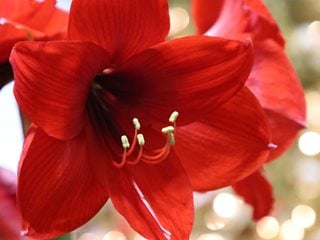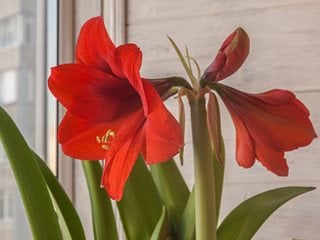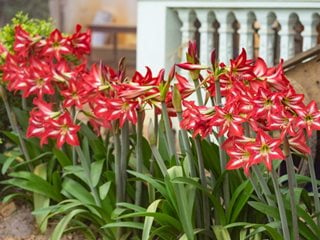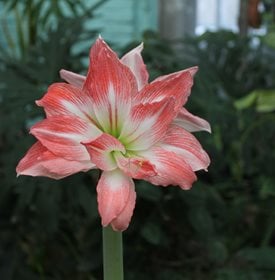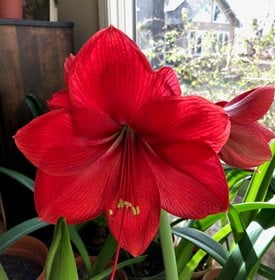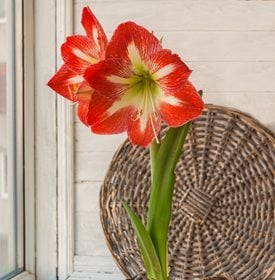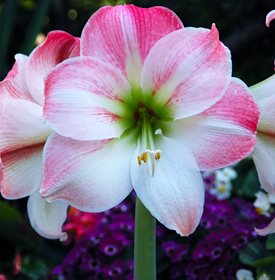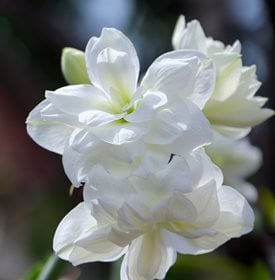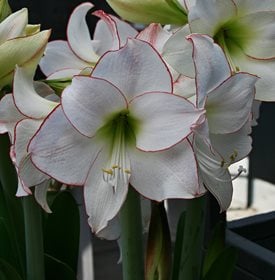How to Grow Amaryllis Flowers
Brighten up the holiday season—and beyond—with this magnificent winter-blooming bulb.With their ability to produce large, vibrantly colored blooms indoors in the depths of winter, amaryllis plants rival the poinsettia as one of the most popular holiday flowers. The spectacular trumpet-shaped blooms brighten the dreariest day and instantly banish the winter doldrums. And depending on when you plant it, amaryllis can actually flower through early spring, enhancing your home with its floral beauty until the outdoor planting season arrives.
On this page: Basics | Growing Indoors | Growing Outdoors | Pictures | Buying Tips
On this page:
- BASICS
- AMARYLLIS CARE & GROWING: INDOORS
- AMARYLLIS CARE & GROUWING: OUTDOORS
- AMARYLLIS VARIETIES
- BUYING TIPS
BASICS
Botanical name:
Hippeastrum
Plant type:
A tropical bulb, native to South Africa and South America.
Zones:
Typically grown indoors; however, can also be grown outdoors in the garden as perennials in frost-free areas of the South and West (Zones 8-10).
Bloom time:
When grown outdoors, amaryllis will naturally bloom in spring.
Height:
12 to 36 inches
Flower size:
Six to ten inches across, usually produces three or four flowers per stem.
Colors/varieties:
Typically in various shades of red, white, pink, peach, or apricot, but there are also many striped, multicolored, and picotee selections; as well as double-flowered and dwarf varieties.
Precautions:
All parts of the plant can be toxic if ingested, especially the bulb. Keep away from children and pets.
AMARYLLIS CARE & GROWING: INDOORS
When to plant:
October until the end of April. It usually takes six to eight weeks for amaryllis to bloom. (Plant in November for New Year's blooms, February for Easter flowers.)
Planting:
Place the bulb in potting mix pointed end up, with its "neck" and “shoulders" above the soil surface. Place in a warm, well-lit spot (such as a south-facing window) until the bulb sprouts. Growth generally begins in two to eight weeks. Succession plant multiple bulbs for continuous blooms throughout winter.
Container:
Choose a heavy pot, such as clay or ceramic, to counterbalance the weight of the large flowers. Amaryllis bloom best when pot-bound, so the container should only be an inch or two wider than the bulb. Make sure your container has good drainage holes.
Support:
Once your plant takes off, a support stake may be needed to hold the flower stems upright.
Soil:
Average potting soil works fine, but the addition of perlite or sand will help to improve drainage and prevent soggy soil.
Water:
Give the bulb a good watering at planting time, and then water sparingly until growth starts. Overwatering when you first pot an amaryllis can cause bulb rot and poor root development. After the plant begins to develop foliage, keep the soil slightly moist. Watering once a week should be sufficient, depending on the heat and humidity in your home.
Lighting/temperature:
Since amaryllis are native to the tropics, warmth and sunlight will encourage them to break dormancy. Place newly potted bulbs in a brightly lit room at 65° to 75° F. Once they begin blooming, move them out of direct sunlight and into a cooler location to prolong the blooming period. Turn the pot a little every day to prevent your plant from leaning toward the light source.
Fertilizer:
A healthy amaryllis bulb contains all the nutrients it needs to bloom. But if you plan to keep your plant for reblooming next year, feed it regularly with a water-soluble houseplant fertilizer.
Growing in water:
It’s also possible to grow an amaryllis in water in a clear glass container. Nestle the roots around a base of pebbles and keep the water level no higher than the base of the bulb, changing it periodically. Be aware that this growing method can deplete the bulb’s reserves, so is not recommended if you want to keep the bulb for reblooming next year.
After blooming:
After all the flowers have faded, remove the stalks but leave the foliage intact. It will produce the fuel the bulb needs to flower again next year. With proper care, an amaryllis bulb can last for decades, but it needs a resting period to replenish its resources. The horticulturists at Iowa State University Extension and Outreach offer tips on getting your amaryllis to bloom again.
AMARYLLIS CARE & GROWING: OUTDOORS
When to plant:
Plant the bulbs in early fall for blooms the following spring. Once indoor-grown plants have finished blooming, they can be transplanted outdoors after being gradually acclimated to outdoor temperatures and light.
Where to plant:
Amaryllis will do best when planted in a location that receives partial shade and in well-draining soil.
How to plant:
Plant similar to indoors, neck deep, leaving the top 1/3 of the bulb sticking up out of the soil.
Water:
Water well at planting and keep moist through the growing season. Somewhat drought tolerant once established.
Fertilizer:
Apply a balanced fertilizer once growth starts in spring, following package directions.
After blooming:
Cut back the flower stalks when done blooming. Let the foliage die back completely before removing it (it is gathering energy for next year's flowers). The bulbs can stay in the ground untended, where they will continue to re-flower and multiply for years to come.
PICTURES
BULB BUYING TIPS
- Amaryllis are sold as dormant bulbs, pre-potted bulbs ready for bloom, or plants already in flower. Bulbs (typically available in autumn) are the most economical option and offer the greatest color selection.
- The larger the bulb, the more flower stalks and blooms it will produce. Many are measured in centimeters, with an average-sized bulb typically 26 to 28 centimeters (slightly larger than a baseball).
- Make sure the bulbs are firm, like an onion, and free of soft spots and discoloration. Avoid any that feel squishy or have dark spots on the surface, which could be signs of rot.
- Store newly purchased bulbs in a cool place (about 40° to 50° F) until you plant them. If the pointed tip of the flower spathe is emerging, your bulb is already growing and should be planted right away.
- You may also find amaryllis bulbs sold in a casing of brightly colored wax. Completely self-sustaining, they don’t need water or soil to flower. Simply place them in a brightly lit room. The downside is a short shelf life and they will bloom only once.
- Dwarf amaryllis are often more prolific and longer lasting. Expect each bulb to produce a larger number of smaller flowers per stem and more stems per plant.
WHERE TO BUY AMARYLLIS BULBS ONLINE:
Updated: 8/17/2021
RELATED:
Bulbs for Warm-Climate Gardens
Forcing Indoor Bulbs
Holiday Classic Décor Elements Made Modern
